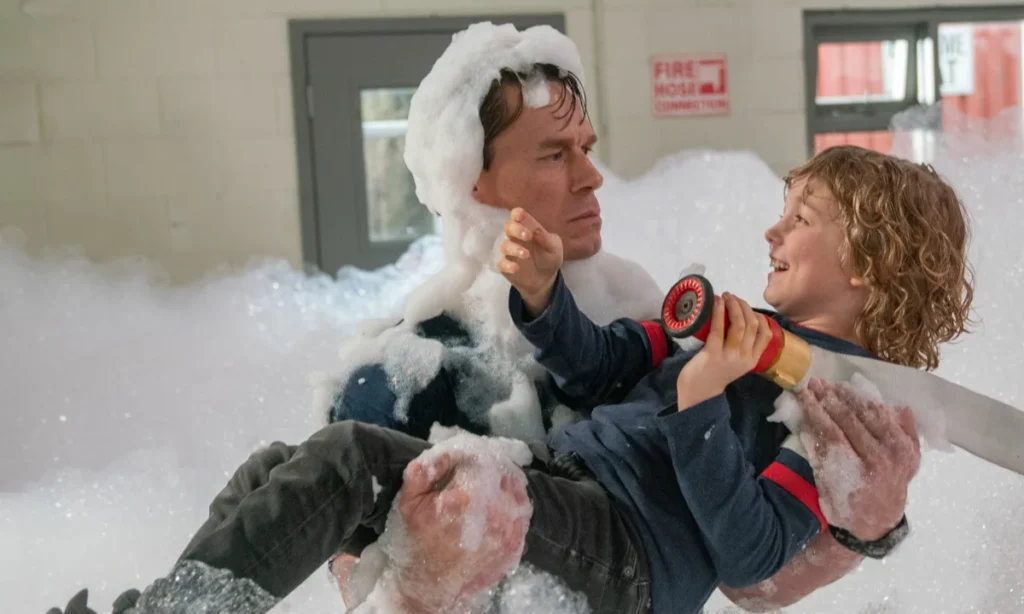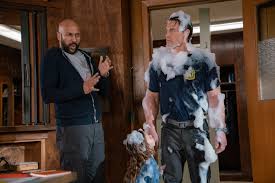Playing with Fire (2019) – A Family Comedy About Chaos, Love, and Firefighters

Introduction
Cinema has always been a medium that brings together diverse genres — action, romance, drama, comedy, and family entertainment. Among them, family comedies hold a special place, as they entertain not just individuals but entire households. These films often blend slapstick humor, heartfelt lessons, and lighthearted storytelling that resonate across generations.
Playing with Fire, released in 2019, is one such movie. Directed by Andy Fickman and produced by Paramount Players, the film attempts to merge the high-adrenaline profession of firefighting with the innocence and unpredictability of children. It stars John Cena, Keegan-Michael Key, John Leguizamo, Brianna Hildebrand, Dennis Haysbert, and Judy Greer.
At its heart, Playing with Fire is about tough firefighters who believe they can handle any emergency — until they are faced with their most unexpected challenge: babysitting three mischievous children. While critics were not kind to the film, families with kids found it enjoyable for its simple humor and heartwarming message about love, family, and responsibility.
This article takes a deep 3000-word dive into Playing with Fire, covering its plot, character arcs, performances, direction, themes, music, critical reception, controversies, and cultural relevance.
Background of the Film

Director – Andy Fickman
Andy Fickman is known for directing lighthearted family films such as The Game Plan (2007) and Race to Witch Mountain (2009). With Playing with Fire, he once again explored the theme of tough adults softening up in the presence of children — a formula that has worked in Hollywood comedies for decades.
Production
The film was produced by Paramount Players, Nickelodeon Movies, and Broken Road Productions. The project was designed as a family-friendly holiday release with John Cena as the central star, capitalizing on his growing reputation as an actor who can balance action and comedy.
Plot Summary of Playing with Fire
The story unfolds in a small California town where a team of elite smokejumpers — firefighters trained to parachute into wildfires — take pride in their tough, disciplined lifestyle.
Act 1 – The Firefighting Team
The team is led by Superintendent Jake Carson (John Cena), a disciplined, no-nonsense leader who dreams of becoming the regional commander, like his mentor Commander Richards (Dennis Haysbert). Alongside him are his loyal but quirky team members:
- Mark Rogers (Keegan-Michael Key) – Jake’s overly enthusiastic second-in-command.
- Rodrigo Torres (John Leguizamo) – A clumsy firefighter with a nervous energy.
- “Axe” Leonard (Tyler Mane) – A silent, burly firefighter known for carrying his axe everywhere.
Their lives revolve around fighting fires and maintaining military-like discipline.
Act 2 – The Rescue
During a dangerous wildfire, the team rescues three children: Brynn (Brianna Hildebrand), the responsible teenage sister; Will (Christian Convery), the mischievous middle child; and Zoey (Finley Rose Slater), the adorable toddler. With their parents away, Jake is forced to take them into the fire station temporarily, despite his reluctance.
What Jake assumes will be an easy babysitting job quickly spirals into chaos. The kids turn the disciplined firehouse upside down with pranks, tantrums, and unpredictable behavior.
Act 3 – Chaos and Heartwarming Moments
As days pass, the firefighters struggle to maintain order. Rodrigo panics over minor mishaps, Mark overreacts to every situation, and Axe silently bonds with Zoey. Meanwhile, Jake tries to stay tough but slowly softens as he grows attached to the children.
Romantic tension also brews between Jake and Dr. Amy Hicks (Judy Greer), a local veterinarian who encourages him to embrace his emotions instead of suppressing them.
The children, especially Brynn, begin to see Jake as a father figure, revealing that their parents are actually deceased. This revelation deepens Jake’s emotional conflict as he realizes the importance of love, responsibility, and family.
Act 4 – Resolution
In the climax, Jake is offered the prestigious commander position he always wanted, but he realizes that family matters more than ambition. When the children’s grandfather tries to take them away, Jake steps in, demonstrating that he is ready to be their guardian.
The film ends with the firefighters embracing their new roles as protectors and caretakers, proving that even the toughest heroes can have soft hearts.
Character Analysis
Jake Carson – John Cena

As Superintendent Jake Carson, John Cena portrays a tough, disciplined leader. His character arc moves from ambition-driven rigidity to embracing vulnerability and love. Cena’s comedic timing, coupled with his physical presence, fits the role well.
Mark Rogers – Keegan-Michael Key
Mark is Jake’s hyperactive deputy, always supportive yet hilariously over-the-top. His dramatic entrances, constant affirmations of Jake’s greatness, and slapstick humor make him a scene-stealer.
Rodrigo Torres – John Leguizamo
Rodrigo is portrayed as neurotic, constantly panicking and overthinking. While some of his humor feels forced, he adds to the team’s comedic chemistry.
Axe Leonard – Tyler Mane
The silent giant with a soft heart, Axe rarely speaks but forms an adorable bond with toddler Zoey. His character balances intimidation with tenderness.
Brynn – Brianna Hildebrand
The eldest of the rescued kids, Brynn is protective of her siblings and skeptical of the firefighters at first. Her emotional depth grounds the film, especially in the revelation about her parents.
Dr. Amy Hicks – Judy Greer
Amy is Jake’s love interest and moral compass, encouraging him to let go of ambition and embrace his humanity. While her role is secondary, she adds warmth to the story.
Themes in Playing with Fire
1. Family Beyond Blood
The film emphasizes that family is not just about biological ties — it’s about love, care, and responsibility. The firefighters, once strangers, become surrogate family to the children.
2. Ambition vs. Responsibility
Jake’s dream of becoming a commander clashes with his newfound role as a caretaker. The story highlights that personal growth often comes from emotional connections, not career achievements.
3. Discipline vs. Chaos
The clash between the rigid, rule-driven world of firefighting and the free-spirited chaos of children drives much of the film’s humor.
4. Grief and Healing
The children’s loss of their parents adds an emotional layer, showing how new bonds can help heal old wounds.
5. Comedy in Contrast
The humor stems from the contrast between tough, disciplined firefighters and mischievous, innocent kids.
Direction and Cinematic Style
Andy Fickman’s direction leans heavily into slapstick comedy and situational humor. The style is exaggerated, with over-the-top reactions, pratfalls, and cartoonish sequences. While this appealed to younger audiences, critics felt it lacked originality.
Cinematography and Visuals
The cinematography by Dean Semler captures:
- Action-packed fire rescue sequences.
- The sterile, disciplined interiors of the firehouse.
- Chaotic, colorful scenes when the children disrupt order.
The contrast visually represents the clash of worlds.
Music and Soundtrack
Composed by Nathan Wang, the score is light, upbeat, and comedic. While it doesn’t feature memorable songs, the background music complements the humorous and emotional beats.
Audience Reception
Critical Reviews
Critics were largely negative, criticizing the film for predictable storytelling and formulaic humor. It holds a low rating on Rotten Tomatoes (22%).
Positive Audience Reactions
Despite critical reviews, families and children enjoyed the film:
- Simple humor appealed to kids.
- John Cena’s charm and comedic performance were praised.
- The heartwarming family message resonated with parents.
Box Office Performance
- Budget: Around $30 million.
- Box Office: Grossed nearly $69 million worldwide.
The film was a moderate commercial success, particularly as family-friendly holiday entertainment.
Controversies
The film did not face major controversies, but some criticisms included:
- Over-reliance on slapstick humor.
- Stereotypical character portrayals (e.g., silent giant Axe, hyperactive sidekick Mark).
- Lack of originality in premise compared to classics like Kindergarten Cop or The Pacifier.
Cultural Impact
While not groundbreaking, Playing with Fire contributed to the genre of family comedies in a few ways:
- John Cena’s Transition: The film cemented John Cena’s reputation as a family-friendly comedy star, following in the footsteps of Dwayne Johnson.
- Nickelodeon Brand: Strengthened Nickelodeon Movies’ lineup of kid-centric comedies.
- Family Bond Message: Reinforced the timeless cinematic theme of unconventional families.
Conclusion

Playing with Fire is a lighthearted family comedy that doesn’t aim for critical acclaim but instead seeks to entertain children and families. It blends firefighting heroism with chaotic babysitting, delivering laughs, heartwarming moments, and lessons about love, responsibility, and family.
While predictable and formulaic, the film succeeds in being exactly what it was designed to be: a fun, safe, family-friendly entertainer. Its greatest strength lies not in originality, but in its simple message — that even the toughest heroes can discover their soft side when faced with the power of love and family.
For kids, it’s silly fun. For parents, it’s a reminder of the chaos and joy children bring into our lives. And for John Cena, it’s another step in proving his versatility as both an action hero and a family entertainer.
